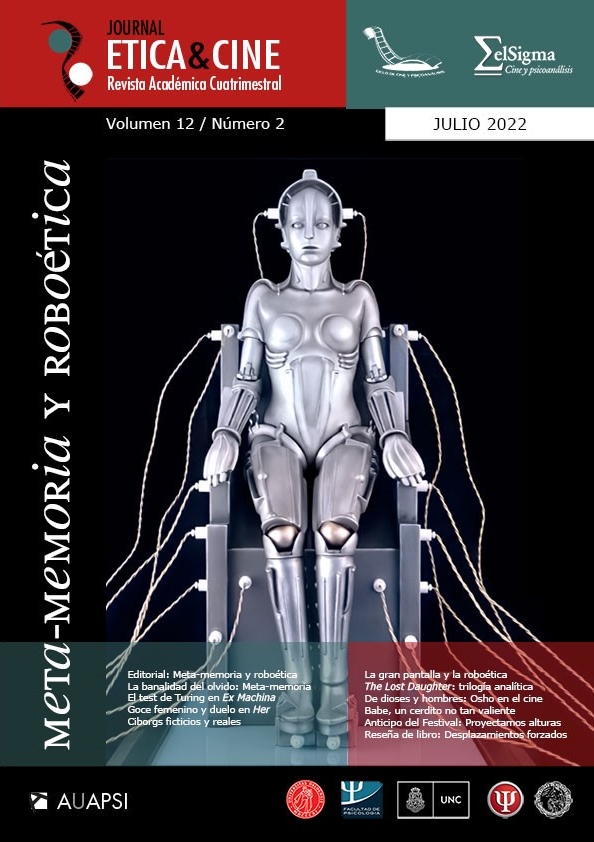The Turing test in Ex Machina: Is Ava an intentional system?
DOI:
https://doi.org/10.31056/2250.5415.v12.n2.38325Keywords:
Bioethics, Artificial intelligence, Motion pictures, Theory of mind, EmotionsAbstract
This article addresses the problem of the interaction between human beings and artificial intelligence based on the Turing test represented in the movie Ex Machina. Some of the main perspectives in relation to the philosophy of mind are reviewed and the problem posed by the film is analyzed, as to whether Ava, the humanoid robot, passes the Turing test, based on three hypotheses: The mental states described by John Searle constitute the three dimensions of the psychic world and moral deliberation: the factual dimension of perception, the estimative dimension of values, and the pragmatic dimension of actions. The second hypothesis affirms that ideas constitute intentional mental states, units of cultural transmission that, associated with emotional states, constitute feelings as neurocultural phenomena. The third hypothesis states that the community of meanings emerging from the link between affects and symbolic-cultural systems can be made up of both human beings and algorithmic systems. In this sense, the proof of strong artificial intelligence consists in the verification in such systems of affective (evaluative) mental states mediated by cultural interaction.
References
Alfonseca, M. (2014). ¿Basta la prueba de Turing para definir la “inteligencia artificial”? Scientia et Fides, 2(2), 129–134.
Arango, G. J. (2017). The theory of intention of John Searle. Sophia, 22, 83–102. https://doi.org/http://doi.org/10.17163/soph.n22.2017.03
Bartra, R. (2007). Antropología del cerebro. Fondo de Cultura Económica.
Block, Ned (1996). What is functionalism? The Encyclopedia of Philosophy Supplement
Braun, R. (2011). La conciencia humana y el emergentismo. Persona, 0(014), 159–185. https://doi.org/10.26439/persona2011.n014.257
Carmona, R. (2019). Materialismo reduccionista y materialismo eliminativo: dos posturas en filosofía de la mente. Revista de Investigación En Ciencias Sociales y Humanidades, 6(2). https://doi.org/10.30545/academo.2019.jul-dic.6
Cassirer, E. (1963). Antropología filosófica. Introducción a una filosofía de la cultura. Fondo de Cultura Económica.
Chalmers, D. (1995). Facing Up to the Problem of Consciousness. Consciousness and Emotion in Cognitive. Science, 3, 207–228. https://doi.org/10.4324/9780203826430-11
Churchland, P. & Churchland, P. (2012). El cerebro moral. Barcelona: Paidós.
Clark, A. (2008). Supersizing the mind: embodiment, action, and cognitive extension. Oxford University.
Clark, A., & Chalmers, D. J. (2011). La mente extendida. CIC Cuadernos de Información y Comunicación, 16, 15–28.
Damasio, A. (1999). El error de Descartes. La razón de las emociones. Santiago de Chile: Editorial Andrés Bello.
Damasio, A. (2009). En busca de Spinoza: Neurobiología de la emoción y los sentimientos. Crítica. https://doi.org/10.1108/EUM0000000004260
Eronen, M. (2004). Emergence in the Philosophy of Mind. Department of Philosophy, 1–79. http://ethesis.helsinki.fi/julkaisut/hum/filos/pg/eronen/emergenc.pdf
Garland A. (Director). (2015). Ex Machina [Película]. DNA Films.
Gracia, D. (2011). La cuestión del valor. Real Academia de Ciencias Morales y Políticas.
Jackson, F. (1982). Epiphenomenal qualia. Philosophical Quarterly, 32, 127-36.
Klin, A., Jones, W., Schultz, R., & Volkmar, F. (2003). The enactive mind, or from actions to cognition: lessons from autism. Philosophical transactions of the Royal Society of London. Series B, Biological sciences, 358(1430), 345–360. https://doi.org/10.1098/rstb.2002.1202
Langer, S.K. (1953). Feeling and Form. A theory of art. New York: Charles Scribner’s Sons.
Lorenzatti, J. J. (2018). Ned Block “El Funcionalismo”. Cuadernos Filosóficos / Segunda Época, (12), 135–149. https://doi.org/10.35305/cf2.vi12.13
Nagel, T. (1986). The view from nowhere. Oxford University Press.
Penrose, R. (1996). La mente nueva del emperador. En torno a la cibernética, la mente y las leyes de la física. Consejo Nacional de Ciencia y Tecnología. Fondo de Cultura Económica de México.
Pérez, M. (2006). Mente y relevancia. Universitas Psychologica, 5(2), 385–396.
Prinz, J. (2007). The emotional construction of morals. Oxford University Press.
Putnam, H. (1967). Psychological Predicates. In Capitan W. H. & Merrill, D. D. (eds.), Art, Mind, and Religion. University of Pittsburgh Press.
Putnam, H. (1991). Representation and reality. MIT Press.
Ryle, G. (2005). El concepto de lo mental (Trad. E. Rabossi). [The Concept of mind]. Paidós.
Searle, J. (2001). Mente, lenguaje y sociedad. Alianza Ensayo.
Searle, J. (2006). La mente una breve introducción (Trad. H. Pons). [Mind: A Brief introduction] Grupo Editorial Norma.
Searle, J. (2015). Find in Worldcat Seeing Things as They Are: A Theory of Perception. Oxford Scholarship Online. https://doi.org/DOI:10.1093/acprof:oso/9780199385157.001.0001
Sheets-Johnstone, M. (2008). Getting to the Heart of Emotions and Consciousness. Handbook of Cognitive Science, 453–465. https://doi.org/10.1016/B978-0-08-046616-3.00023-2
Spinoza, B. (1994). Ética demostrada según el orden geométrico. Ediciones Orbis S.A.
Tiku, N. (11 de junio de 2022). The Google engineer who thinks the company’s AI has come to life. The Washington post. https://www.washingtonpost.com/technology/2022/06/11/google-ai-lamda-blake-lemoine/
Turing, A. M. (1950). Computing Machinery and Intelligence. Mind, 59(236), 433–460.
Uribe, M. (2002). Epistemología, Filosofía de la mente y bioética. Revista Colombiana de Psiquiatría, 31(4), 335–338.
Van Oudenhove, L., & Cuypers, S. E. (2010). The Philosophical “Mind-Body Problem” and Its Relevance for the Relationship Between Psychiatry and the Neurosciences. Perspectives in Biology and Medicine, 53(4), 545–557. https://doi.org/10.1353/pbm.2010.0012
Warwick, K., & Shah, H. (2016). El futuro de la comunicación humano-máquina: el test de Turing", en El próximo paso. La vida exponencial. BBVA https://www.bbvaopenmind.com/wp-content/uploads/2017/01/BBVA-OpenMind-Kevin-Warwick-Huma-Shah-El-futuro-de-la-comunicacion-humano-maquina-el-test-de-Turing.pdf
Wittgenstein, L. (1988). Investigaciones filosóficas (Trad. C. U. Moulines & A. G. Suárez). [Philosophische Untersuchungen]. Crítica D.L.
Wright-Carr, D. C. (2018). La ciencia cognitiva corporeizada: Una perspectiva para el estudio de los lenguajes visuales. Entreciencias: Diálogos en la Sociedad del Conocimiento, 6(16), 81–96. https://doi.org/10.22201/enesl.20078064e.2018.16.63364
Downloads
Published
Issue
Section
License
Copyright (c) 2022 Ética y Cine Journal

This work is licensed under a Creative Commons Attribution-ShareAlike 4.0 International License.
Los autores que publiquen en Ética y Cine Journal aceptan las siguientes condiciones:
Los autores/as conservan los derechos de autor © y permiten la publicación a Ética y Cine Journal, bajo licencia CC BY-SA / Reconocimiento - Reconocimiento-CompartirIgual 4.0 Internacional. La adopción de esta licencia permite copiar, redistribuir, comunicar públicamente la obra, reconociendo los créditos de la misma, y construir sobre el material publicado, debiendo otorgar el crédito apropiado a través de un enlace a la licencia e indicando si se realizaron cambios.

Este obra está bajo una licencia de Creative Commons Reconocimiento-CompartirIgual 4.0 Internacional.




